Caladium Plant Care (Indoors and Outdoors) – And When to Plant Caladium Bulbs

Caladium plants are beautiful tropical tender perennials with stunning, multicolored heart-shaped leaves. Caladium bicolor—also called Heart of Jesus—is the most popular species of the shade-loving leafy plant. Caladium leaves can be magnificent color combinations of pink, green, red, and white. Caladiums are easy to grow as summer annuals or spectacular houseplants.
Most caladium varieties are cultivars of the species Caladium bicolor. This tropical plant originates from South America. The common names of Caladium bicolor cultivars generally describe the vibrant, colorful heart-shaped leaves. Some examples are ‘Florida Red Ruffles,’ ‘Red Flash,’ ‘Strawberry Star,’ and ‘White Dynasty.’
This article is a complete guide to growing colorful caladium plants. You will find helpful advice on making sure that caladiums thrive indoors as colorful houseplants. Additionally, you will learn about caring for caladium plants in a summer garden.
How to Care for Caladium Plants
To care for caladium plants, grow the unusual tropical foliage plants in a shaded location. Caladiums grow best in a light, rich, well-draining potting mix that is evenly moist. Water the plant when the soil feels dry. Fertilize caladiums every two weeks in the growing season. The minimum temperature for caladiums is 65°F (18°C).
In cold climates, grow species of Caladium bicolor as colorful foliage houseplants. Alternatively, dig up the caladium bulbs from your garden and store them in a cool, dry place for replanting the following spring.
Facts About Caladium Plants
Caladium is a genus of tropical, flowering plants in the family Araceae. Caladiums have leaves in heart shapes or that look like rounded arrowheads. Although caladiums bloom with flowers that look like calla lilies, they are grown for their spectacular colorful foliage.
Heart of Jesus is the most common name for Caladium bicolor plants. You may see Caladium bicolor plants sold under the botanical name Caladium x hortulanum. Other names for caladium include ‘elephant’s ear’ and ‘angel wings.’
There are over 1,000 caladium cultivars.
Caladium plants in pots grow around 24” (60 cm) high and are about the same width. You can also find dwarf Caladium bicolor cultivars if you want a compact houseplant with smaller leaves.
Caladium plants are related to other plants that share the name ‘elephant ears.’ You may find plants in the genera Alocasia, Colocasia, and Xanthosoma also share the common name with Caladium. So, to know what you’re buying, it’s best to look at the botanical name.
Caladium plants grow in USDA zones 10 through 12. In their native habitat of Brazil and South America, Caladium species grow on the shaded rainforest floor. Their native environment is warm, humid, and shaded. For this reason, caladium plants are typically grown in pots as perennial houseplants or annuals in colder climates.
Caladium Flowers
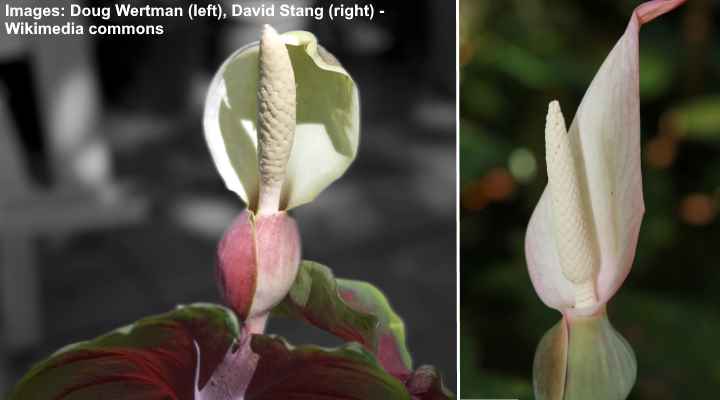
Close up pictures of caladium flowers
Caladium flowers are small white flowers that are typical of plants in the family Araceae. The flowers consist of a small flowering spike called a spadix. This is surrounded by a spathe, which looks like a white curled leaf. Sometimes, caladium flowers are called spathe flowers.
Caladiums growing as annuals outdoors or perennial houseplants rarely flower. However, there’s nothing to worry about. The stunning color combinations on the pointed, heart-shaped leaves make up for any lack of blooming on a caladium plant.
Caladium Leaves
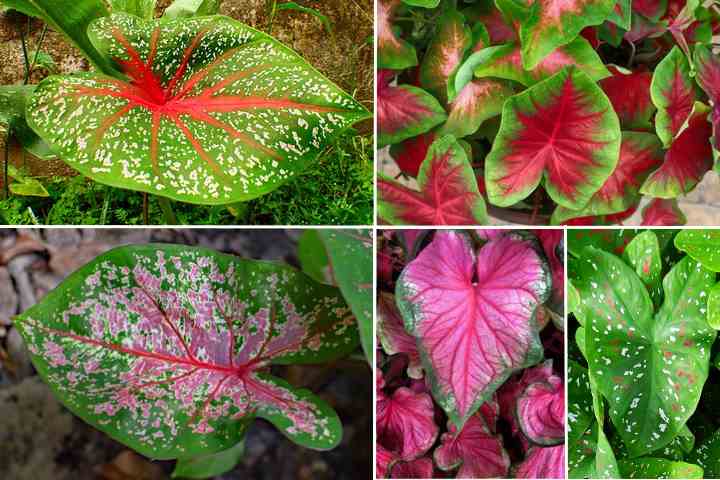
Caladium leaves come in a wide array of beautiful color combinations
Caladium leaves are the most attractive features of this foliage plant. Leaves on caladiums are either heart-shaped with a pointed end and wide, rounded base. Or they can be narrower and look like arrowheads or lanceolate-shaped leaves. All caladium plants have lush bi-colored or multicolored leaves.
Here are the two types of caladium leaves:
- Fancy leaf caladiums. Caladium plants with broad, long heart-shaped leaves are classified as ‘fancy leaf caladiums.’ The leaf stem (petiole) attaches near the leaf’s middle. Typically, caladiums with fancy leaves grow best in the shade.
- Strap leaf caladiums. Caladium leaves that are narrower with tapered tips are ‘strap leaf caladiums.’ These caladium leaves are described as lance-leaved or arrowhead leaves. Strap leaf caladium leaves have petioles that attach to the leaves’ base. Caladiums with strap leaves are more tolerant of brighter growing conditions.
All varieties of caladium have spectacular foliage. The caladium leaves could have splashes of color, pronounced veins, or speckled vibrantly-colored dots. Color combinations of caladium leaves can be dark green and bright pink, white and green or red, or light pink and lime green.
But because there are thousands of Heart of Jesus (Caladium bicolor) cultivars, the color combinations and leaf patterns are almost endless.
Caladium Bulbs
Caladium bulbs are tuberous roots called corms. Caladium leaves grow directly from the bulbs that are planted a few inches deep in the soil. Caladium bulbs don’t tolerate frost or cold temperature. If you grow caladiums as annuals, you’ll need to dig up the bulbs and overwinter them indoors.
To winterize caladium bulbs, carefully dig them up after fall when the leaves start turning yellow. It’s vital to leave the foliage attached to the caladium bulbs. Place the tubers in a cool, dark room for three weeks. During this time, the caladium goes dormant.
After the bulbous roots have dried, remove the leaf stems, brush off loose dirt, and store them over winter in a dry place at 50°F (10°C).
How to plant caladium bulbs
Plant caladium bulbs outdoors when there is no risk of frost. Ideally, the soil temperature should be between 60°F and 70°F (15°C – 21°C). In some locations, you’ll need to wait until late spring or early summer to plant caladium bulbs outdoors. Plant the caladium tubers in a shaded spot in your backyard.
The time to plant caladium bulbs indoors is about six to eight weeks before you plan to transfer to your yard. In spring, planting caladium tubers also ensures that they grow fast, even if you decide to grow the plants as an indoor houseplant.
Plant the caladium bulbs with the bumpy or knobby side facing up so that they’re not upside down. Press into the moist potting soil, so they are about 2” (5 cm) below the surface. Plant the bulbs in a bright location that is at least 70°F (21°C) to start the plant’s regrowth.
Caladium Care Guide
Where to Plant Caladium Bulbs
The best location to grow caladium plants in your garden is in filtered sun or shade. You should also check that there is protection from wind. Caladium leaves tend to be thin and delicate, and they are easily damaged in strong winds.
How to Grow Caladium Plants Indoors
Tropical perennial plants such as Caladium bicolor species grow well indoors. It’s vital to place the plant pot away from direct sunlight. Also, Heart of Jesus plants need warm, humid conditions to thrive.
However, it’s good to remember that all caladium species die back in winter and enter dormancy. When this happens, you can store the bulbs for replanting the following year.
Light Requirements to Care for Caladium
Caladium plants thrive in shade or partial shade. Growing outdoors or indoors, protecting delicate caladium leaves from direct sunlight is crucial. Intense midday sun can scorch the leaves and fade their vibrant colors. However, different Caladium bicolor cultivars can withstand varying light conditions.
Typically, fancy leaf caladiums are more shade-loving. Their large, broad leaves can be easily damaged in direct sunlight. If you want to grow angel wings plants in a sunny location, choose a strap leaf caladium cultivar. Plants with narrower leaves can withstand more sunlight.
Many new caladium cultivars have a high tolerance for bright sunlight.
The Best Soil for Growing Caladium Outdoors and Indoors
Caladium grows best in soil that is rich in organic material and has excellent drainage. To create the ideal potting soil, mix one part peat moss, one part houseplant soil, and one part perlite. This potting mix for angel wings retains enough moisture, and the addition of perlite improves drainage.
When preparing the soil to plant caladium bulbs in your garden, it’s good to work in peat moss and gravel or perlite for drainage.
The most critical care tip when growing caladium plants is to prevent the soil from becoming waterlogged. The caladium tubers quickly start to rot if they sit in soggy soil for too long.
How to Water Caladium Plants
Water caladium plants regularly to prevent the soil from drying out. You may have to water caladiums in hot weather as often as every day if the soil dries out fast. If the potting mix feels dry to touch, then it’s time to water your indoor caladium plant.
If you’re growing caladiums in your yard, a layer of mulch around the plant’s base can help control moisture levels.
Here are some useful tips on watering caladium plants:
- Check to see if the top 1” (2.5 cm) of soil is dry before watering.
- Water caladiums as often as you need to so that the soil around the bulbs is evenly moist.
- Caladium growth becomes dormant in winter, and you shouldn’t water the bulbs.
Temperature Range for Caladium Care
The Heart of Jesus plant grows best in warm, tropical temperatures. The ideal temperature range—indoors or outdoors—for caladiums is between 70°F and 75°F (21°C – 23°C) during the day and 60°F to 65°F (15°C – 18°C) at nighttime. Plants in the genus Caladium are not tolerant of cold temperatures.
If you live in USDA zones 10 and 12, you can grow angel wings plants outdoors throughout the year. You can also grow caladium bulbs indoors in temperate climates and take them outside when it’s warm.
Humidity Requirements for Growing Caladium
All varieties of Caladium have high humidity needs. Try to keep indoor humidity at least 50 percent to prevent the showy leaves from curling and turning brown. You can boost air moisture by placing the caladium pot on a pebble and water tray or using a room humidifier.
You can spray a fine mist on caladium leaves. However, due to their high humidity requirements, misting may not be enough to keep tropical plants in the right humid atmosphere.
Top tip when growing caladium plants indoors: Grow plants together to increase humidity and prevent the leaves from drying out. Household air tends to be too dry for tropical plants.
How to Fertilize Caladium Plants
Angel wings plants benefit from regular fertilizing during the growing season. Apply a diluted liquid houseplant fertilizer at half strength every one to two weeks during summer. When the caladium starts to die back, and the leaves turn yellow, stop fertilizing.
Repotting Caladium Houseplants
It’s usually necessary to repot caladium houseplants every spring. It would typically be best if you overwintered caladium bulbs in a dark, cool, dry location. The time for repotting winterized bulbs is in early spring.
To plant caladium bulbs the right way up, look for the pointed tip or the bumpy side on the bulb. This part of the corm should point upward. Plant the caladium tuber about 2” (5 cm) deep in a loose, porous potting mix. Then thoroughly water the soil to remove any air pockets.
Top growing tip for planting caladium bulbs: Don’t worry about planting caladium bulbs upside down. The plant usually finds its way out of the pot and starts growing—only taking an extra few weeks to emerge.
Propagating Caladium Plants
The best way to propagate caladium plants is by dividing the bulbs. Before replanting in spring, look for bulbs that have at least one eye or knobby bit. Divide the tuber, so there is at least one eye on each section. Leave for a day or two so that the wound dries. Then, plant the bulbs as usual.
Pruning Caladium
Prune dead or decaying leaves from caladium plants by snipping off the stems at the soil line. You can also remove caladium flower buds as they start to appear. You can also prune off dead foliage after the plant dies back and you’ve removed the corms from the ground or potting mix.
Pests Affecting Caladium Plant Growth
Caladium plants tend to be relatively resistant to pests. However, if growing conditions aren’t ideal, you could have problems with aphids, mealybugs, or spider mites. It is also possible that caterpillars, grasshoppers, or snails could be attracted to the bright, colorful caladium leaves.
Get rid of pests by applying a neem oil solution. Mix 2 tsp. neem oil and 1 tsp. liquid dish soap in a quart (1 l) of water. Mix in a spray bottle and douse the caladium leaves once a week to eradicate pesky insects and larvae.
Related reading: How to get rid of common houseplant pests.
Diseases Affecting Caladium Plant Growth
You can prevent diseases from killing a tender caladium perennial by watering the plant correctly. Overwatering or poor drainage can cause caladium bulbs to start decaying. Soon, fungal infections will eat away at the root, causing the beautiful foliage to turn yellow.
If you suspect a fungal tuber disease, it’s best to dig up the plant or remove it from the pot. Cut off any mushy root parts and replant the tuber in moist soil. Remember to only water caladiums enough to keep the soil moist but not damp.
Are Caladium Plants Toxic?
Caladium plants are toxic to humans, as well as cats and dogs. Doctors say that all parts of plants in the Caladium genus, including Caladium bicolor, are harmful if swallowed or chewed. Exposure to the plant can cause skin rashes and severe itching.
Additionally, the ASPCA says that elephant ears plants in the Araceae family, including Caladium species, are toxic to dogs and cats.
FAQ About Growing Caladium Plants
Why are my caladiums drooping?
Underwatering is the most common reason caladium leaves wilt and start to droop. You should water caladium plants often enough so that the soil is evenly moist but never soggy. Try giving the tropical plant more water to help bring it back to life.
Why are my caladium plant leaves turning yellow?
A lack of humidity is often to blame for caladium leaves becoming yellow. However, too much watering could also cause yellowing leaves if the roots are decaying. So, it’s vital to check how well you’re caring for your tropical houseplant.
It’s good to remember that caladiums die back before winter, and their leaves turn yellow. Yellow leaves on a caladium growing outside usually mean it’s time to dig up the bulbs and winterize them, ready for planting the following spring.
How do you revive a caladium?
Caladium bulbs go dormant during winter. If you overwinter your bulbs, you can revive them in spring before planting them in your garden.
About eight weeks before you plant the caladium bulbs in your garden. You can plant the bulbs in a light, moist potting mix, making sure there are about 2” below the soil’s surface. After about three weeks, the bulb should start to regrow.
Species of Caladium Plants
Heart of Jesus Caladium (Caladium bicolor)
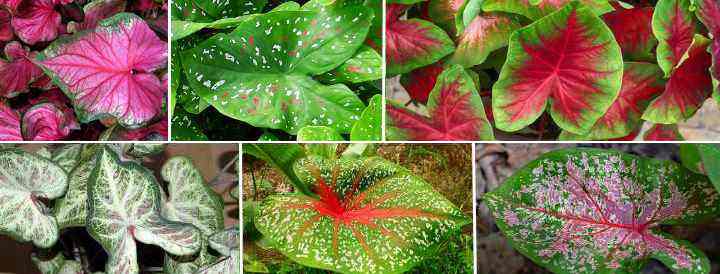
The Heart of Jesus is the main Caladium bicolor species plant. This fancy leafed caladium has large heart-shaped, thin, papery leaves. Heart of Jesus cultivars have stunning leaves in multiple color and pattern combinations.
Some pointed heart leaves look completely pink with green edges. Others are green with white speckles and striking red veins that look like a giant spider. Some Heart of Jesus cultivars have green leaves that look as if pink, white, or red paint was splashed on them.
Moonlight Caladium (Caladium bicolor ‘Moonlight’)

Moonlight Caladium is a fancy leaf plant with huge, brilliant white, almost translucent leaves with green margins and veins. ‘Moonlight’ caladium leaves can grow up to 6” (15 cm) long.
White Dynasty Caladium (Caladium bicolor ‘White Dynasty’)

The magnificent ‘White Dynasty’ is a sun-tolerant caladium with bright, creamy-white leaves and green margins.
Caladium Lindenii
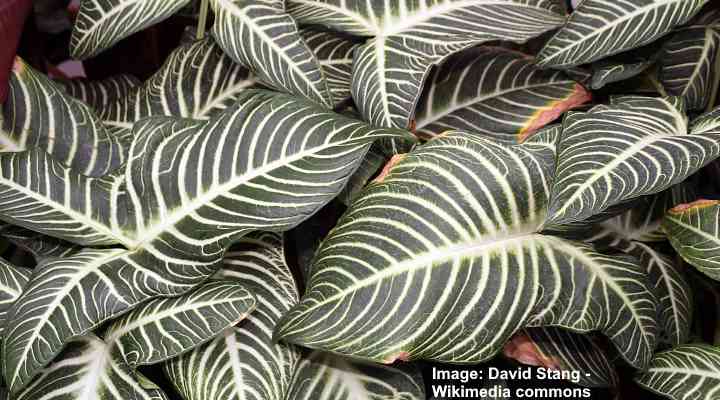
The striking Caladium lindenii has green, pointed arrowhead leaves with unique creamy-white veins that resemble leaves from an African mask plant.
Florida Sweetheart Caladium (Caladium bicolor ‘Florida Sweetheart’)
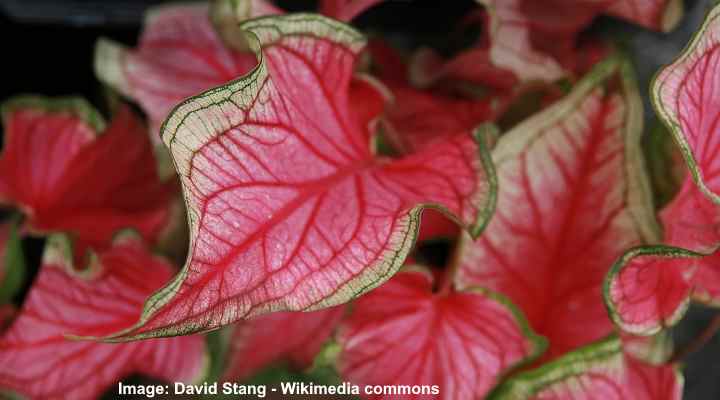
The stunning ‘Florida Sweetheart’ is a strap leaf caladium with rosy-red, bi-colored leaves and green borders.
Caladium ‘Red Flash’ (Angel wings ‘Red Flash’)

The eye-catching ‘Red Flash’ caladium has olive-green, heart-shaped leaves with deep red veins and pink speckles adorning the leaves.
Caladium ‘Florida Red Ruffles’
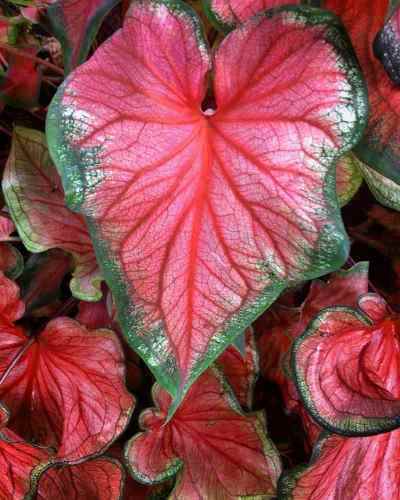
The ‘Florida Red Ruffles is a strap leaf caladium with bi-colored red and green leaves that feature wavy margins and pointed tips.
Caladium ‘Strawberry Star’ (Caladium bicolor ‘Strawberry Star’)
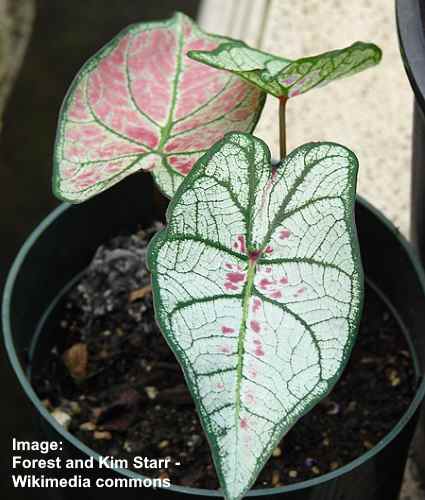
‘Strawberry Star’ is an ornamental caladium houseplant that features brilliant white, almost translucent leaves with green veining and splashes of pink color.
Caladium ‘Carolyn Whorton’ (Caladium bicolor ‘Carolyn Whorton’)
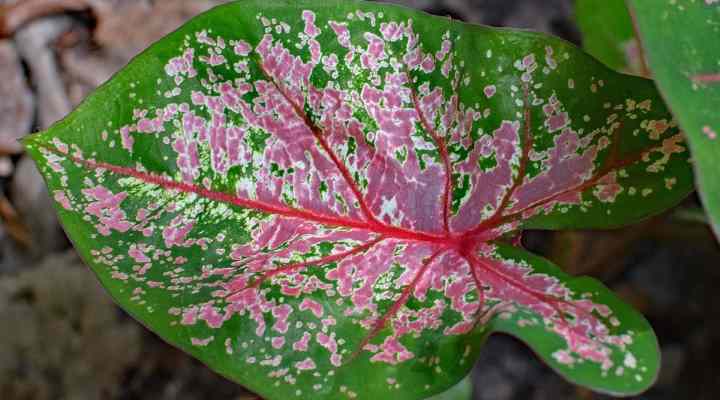
The sun tolerant ‘Carolyn Whorton’ caladium has large, heart-shaped leaves with pink, red, and green colors. Dark-green margins surround pink leaves that feature red veins in the center.
Related articles:
